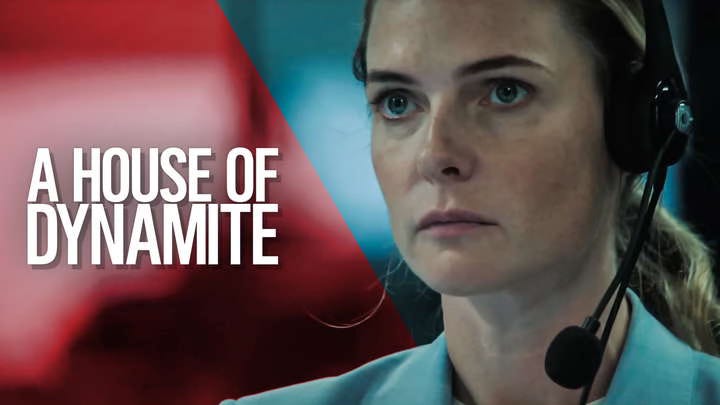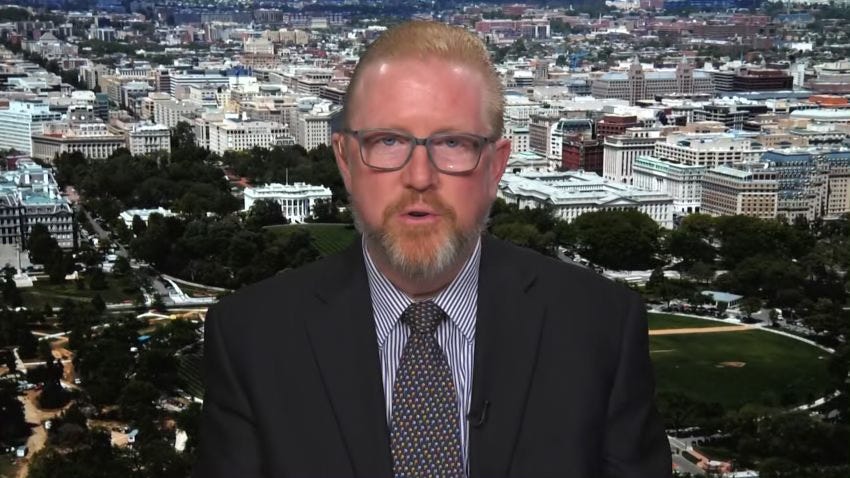Stage Fright in the Sit Room
A House of Dynamite exposes many weaknesses in US nuclear defenses—including psychological pressures that could cause defense professionals to crack up.

It may be the most terrifying moment in Kathryn Bigelow’s riveting new movie, A House of Dynamite: A nuclear-armed intercontinental ballistic missile (ICBM) has just been launched from somewhere in the North Pacific and Air Force trackers quickly determine it is headed to Chicago. The Pentagon’s much vaunted Ground-based Missile Defense (GMD) system is activated to intercept the missile. When the Secretary of Defense demands to know the likelihood of success, the deputy national security advisor waffles, then finally blurts out his sobering reply: The system’s “success rate” is no more than 61 percent.
“So it’s a fucking coin toss?!” the SecDef shouts.
And the fate of Chicago hangs on the outcome.
During the height of the Cold War, Hollywood churned out films about the horrors of nuclear warfare: On the Beach, Fail Safe, Dr. Strangelove. It was an era when politicians pushed for bomb shelters and children were instructed to “duck and cover” under their school desks. Decades later, with the collapse of the Soviet Union, the nightmare scenarios that Baby Boomers grew up with have faded. But they shouldn’t have. As Bigelow’s film reminds us, the possibility of something unspeakably awful happening with a nuclear bomb has never gone away— and the goal of a perfect nuclear defense, most recently touted by President Trump with his talk of a “Golden Dome,” remains a chimera.
“I think most people would be surprised we have so little defense against ICBMs,” said Todd Harrison, a senior fellow at the American Enterprise Institute, who has written about the issues raised by the movie. “For decades, folks in Congress over and over again have tried to get [funding] for more of these ground-based interceptors and proposed building a new site [to launch them.] But we haven’t gotten the system to a level of effectiveness and reliability that it is worth investing.”
Indeed, as Harrison points out, the GDM system—created some two decades ago during the George W. Bush administration—has been replete with miscues over the years. The system was specifically designed to thwart a North Korean missile attack, precisely the scenario envisioned in House of Dynamite, and it has expanded over the years to include 40 “kill” interceptors based in Fort Greely, Alaska and another four in Vandenberg Space Force Base in California.
But the Pentagon has consistently overstated the ability of the interceptors to hit their targets (likened in A House of Dynamite to trying to hit a bullet with a bullet.) A GAO report in 2016 noted that “key aspects” of the system needed to protect against a ballistic missile attack “have not been demonstrated.” Although test results have improved slightly since then, “there have been a lot of failures,” says Harrison, adding that the 61 percent figure is essentially “accurate” and that “no system will be 100 percent effective.”
Coping Mechanisms
The unreliability of missile interceptors is only one of the disturbing vulnerabilities in our nuclear defenses highlighted in the Bigelow film. The other is the ability of even the country’s most seasoned national security professionals to cope with the monumental stress from a crisis of this kind.

In the film, national security officials assembled in the White House Situation Room are alerted to a sea-based ballistic missile launch in the Pacific Ocean that, after a few calculations from the Air Force trackers, is determined to be headed to the continental United States—with a projected impact of 20 minutes. Orders are given to launch the interceptors in Alaska; all three that are fired miss. As the nuclear-tipped ICBM speeds to Chicago, some officials buckle under the pressure. The Secretary of Defense, played by actor Jared Harris, breaks down and desperately calls his estranged daughter in Chicago. The top duty officer—played by Rebecca Ferguson, a woman with nerves of steel until nearly the end— rushes from the Sit Room to call her husband, telling him to take their son and get out of town, right away. Just drive West, she says.
Larry Pfeiffer, a former director of the White House Situation Room between 2011 and 2013 who served as a technical advisor to the film, tells the SpyTalk podcast that Bigelow and her screenwriter, Noah Oppenheim, get many of the details right. The look and feel of the Situation Room— actually a warren of offices— is accurately rendered (thanks to a rare tour Pfeiffer, a former top CIA officer, arranged for the two of them) as well as the protocols for those assigned to it, including dropping off your cell phones in secure cubbyholes before entering.
Also accurate is the very real concern that Sit Room professionals could crack under the enormous pressure of the job. Indeed, Pfeiffer reveals to SpyTalk that when he was Sit Room director, he even had to reject some of those assigned to it as psychologically unfit (although he candidly admits he never experienced a crisis quite as frightful as the one in the movie).
“So when we would interview people to come work in the Situation Room--they come on anywhere from a one to two year detail, [and] the people that are sent are the best and brightest from their agencies and departments—one of the things that I would discuss [with them] is you need to be able to juggle a lot of balls at one time,” Pfeiffer said. “You need to be able to go from zero to a hundred miles an hour in a split second, which I think they demonstrate very well in this movie. And you need to maintain your composure. And if you aren’t able to do that, we’re going to move you back home because we can’t have that.
“And there were times in my tenure where there were individuals who suffered what I would call stage fright,” he added. “They would suddenly be on a phone call with the secretary of defense and have to connect them with the vice president or the president. And they would crumble under that. If there was just even an emergency half as scary as the one depicted in this movie, some people just get emotional and it’s like, ‘Hey, we can’t have this,’ so we would move them on.”

All of which raises the most pressing question of all: is there any realistic way to protect against the threat of nuclear mass murder posed by A House of Dynamite? The film doesn’t really offer any answers. But as Pfeiffer explains, the threat is as real as it’s ever been.
More countries, he notes, have nuclear weapons than ever before; some of them-- North Korea, China and Russia— are U.S. adversaries while others, like Iran, continue to seek them. India and Pakistan, meanwhile, seem regularly on the brink of a nuclear exchange.
“We just haven’t as a nation had a legitimate conversation about nuclear weapons,” he said.
A House of Dynamite— now in theaters, and slated for release on Netflix next week— is sure to start one. ###
Update: A previous version of this story said a Situation Room official noted the middling success rate of ICMB interceptors. It was the the deputy national security advisor.
The SpyTalk podcast appears every Friday afternoon on Simplecast, Apple, Spotify or wherever your preferred listening platform.



As I recall, the point of mutually assured destruction was to ensure that neither side could survive a nuclear strike. The ABM, Star Wars and other systems were not only chimeric in their supposed targeting abilities. They were inherently destabilizing because they made the threat of a nuclear exchange less frightening.
Just a minor (and insignificant) distinction, "an era when politicians pushed for bomb shelters" since many did want them. But the plans were for "fallout shelters" to save people after the bombs created deadly fall out. Robert Heinlein built a fall out shelter in Colorado. In his book it was used as a bomb shelter and a time travel box.
(Farnham's Freehold
Novel by Robert A. Heinlein).